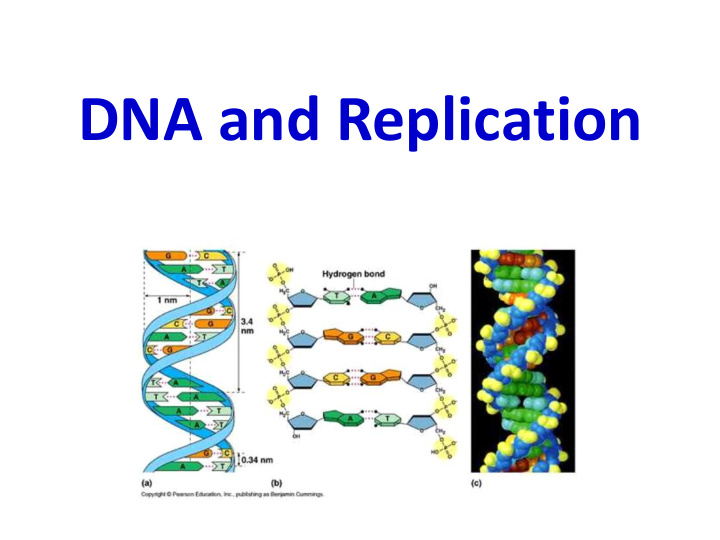



DNA and Replication
DNA: The Primary Source of Heritable Information • Genetic information is transmitted from one generation to the next through DNA or RNA
Chromosomes • Non-eukaryotic (bacteria) organisms have circular chromosomes • Eukaryotic organisms have multiple linear chromosomes • Exceptions: – Some bacterial cells have linear chromosomes – Mitochondria and chloroplasts have been found to have circular and linear chromosomes
Plasmids • Prokaryotes, viruses and eukaryotes (yeast) may contain plasmids • Plasmids are small extra-chromosomal, double-stranded circular DNA molecules • Plasmids make excellent cloning vectors
Plasmids as Cloning Vectors
Important Historical Experiments • The proof that DNA is the carrier of genetic information involved a number of important historical experiments, including: – Frederick Griffith – Avery-MacLeod-McCarty – Hershey-Chase – Watson, Crick, Wilkins and Franklin
Frederick Griffith • 1928 - Experiments in bacterial transformation • Smooth (S) pathogenic bacteria • Rough (R) nonpathogenic bacteria
ANIMATION Frederick Griffith • Living bacterial cells were converted to disease causing bacteria (transformation) • “Transforming factor”
Avery-MacLeod-McCarty Experiments • Experiments demonstrated that DNA is the “transforming” material, not protein
Avery-MacLeod-McCarty Experiments • Used different enzymes to destroy protein, RNA or DNA in separate tubes to determine if transformation occurs
Hershey-Chase Experiment • 1952 - Concluded that DNA, not protein, functions as the genetic material of phage T2
ANIMATION Hershey-Chase Experiment • Tagged protein coat with radioactive sulfur • Tagged viral genome with radioactive phosphorus
Erwin Chargaff • 1952 - Nitrogenous base composition • % of adenine is equal to % of thymine • % of guanine is equal to % cytosine • Composition of DNA varies from species to species
Maurice Wilkins and Rosalind Franklin • 1951 - Worked with a technique called X-ray diffraction • Determined the helical nature of DNA
James Watson and Francis Crick • 1953 – Determined the structure of DNA using Chargaff’s and Franklin’s data • Franklin’s picture showed two strands of nucleotides
DNA ( D eoxyribo n ucleic a cid) • Nucleic acid • Consists of monomers called nucleotides • Stores genetic information, determines an organisms traits by synthesizing proteins • Each organisms genome is unique
ANIMATION Structure of DNA • Double helix • Consists of a double strand of nucleotides • Two strands are anti-parallel: strands are oriented in opposite directions – 5’ to 3’ – 3’ to 5’
Nucleotide Composition • Three parts of a nucleotide – 5 carbon sugar called deoxyribose – Phosphate group – A single nitrogenous base
Four Nitrogenous Bases • Purines (double ring) • Pyrimidines (single ring) – Adenine (A) – Thymine (T) – Guanine (G) – Cytosine (C)
Purines pair with Pyrimidines
Chargaff’s Rules • A-T (2 hydrogen bonds) • C-G (3 hydrogen bonds)
DNA Replication
Why do cells need to replicate DNA?
ANIMATION Semi-Conservative Replication • New DNA molecules have one original template strand and one new strand • Follows complementary base pair rules and begins at sites called origins of replication • “Leading strand” – continuously synthesized • “Lagging strand” – synthesized in fragments
Semi-conservative Replication
Origin of Replication - Prokaryotes
Origins of Replication - Eukaryotes
Replication Bubbles
Enzyme Functions • Helicase • RNA Primase • DNA Polymerase III • DNA Polymerase I • DNA Ligase • Topoisomerase • Single-strand binding proteins (not an enzyme)
Replication Direction • Replication proceeds in the 5’ to 3’ direction • DNA polymerase can only add free nucleotides to the 3' end of the newly forming strand
ANIMATION More animations for your viewing pleasure…. DNA Replication Animation Steps of DNA Replication
Recommend
More recommend